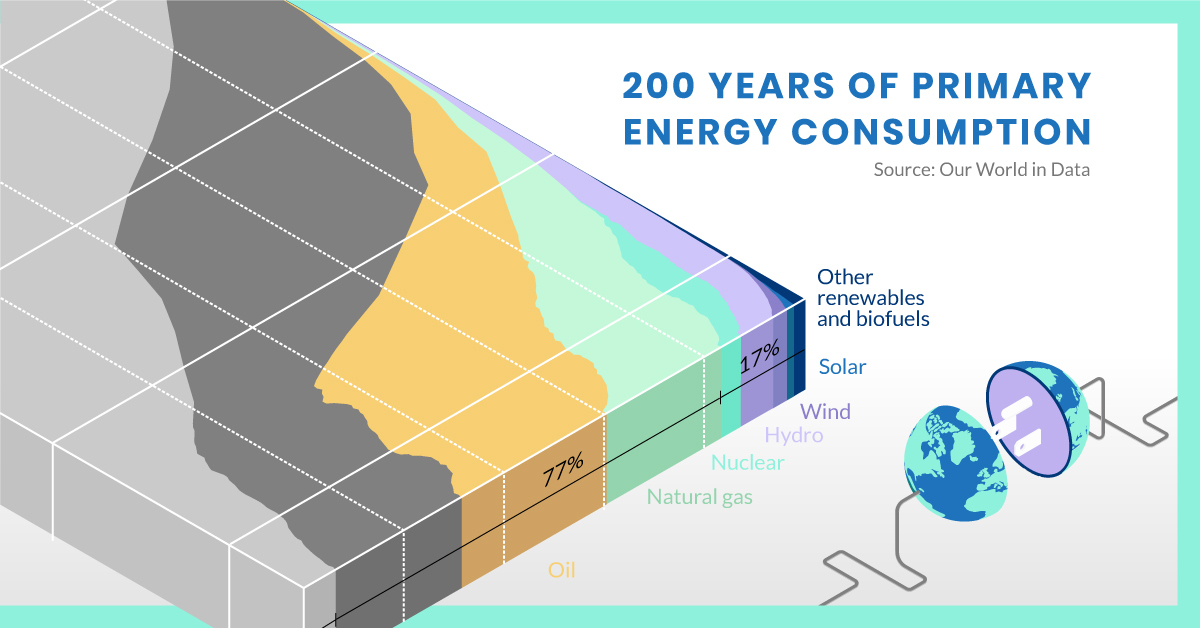Visualizing the Past and Future of Energy Transitions
Visualizing the Past and Future of Energy Transitions
As the world gears up for clean energy, looking back at the history of energy transitions can help identify lessons for the future.
What have shifts in the global energy system looked like in the past, and how can we accelerate the ongoing transition?
The above infographic sponsored by CanAlaska Uranium explores the history of shifts in the global energy mix and highlights the key to a faster clean energy transition. This is Part 1 of 4 in the Road to Energy Utopia series.
Energy Transitions: A Brief History
Prior to the 1800s, people mainly relied on biomass like wood, dry leaves, and charcoal for heating and energy. Carriages driven by animals were the primary means of transport.
The first energy transition, from biomass to coal, began with the Industrial Revolution. This shift was largely driven by the rise of coal-fired steam engines, which found their way into railways, factories, and ships.
To put that into perspective, here are the shares of different energy sources in the global energy mix since 1800:
| Year | Traditional Biomass | Renewables | Nuclear | Coal | Oil | Gas |
|---|---|---|---|---|---|---|
| 1800 | 98% | 0% | 0% | 2% | 0% | 0% |
| 1850 | 93% | 0% | 0% | 7% | 0% | 0% |
| 1900 | 50% | 0% | 0% | 47% | 1% | 1% |
| 1950 | 26% | 3% | 0% | 44% | 19% | 7% |
| 2000 | 10% | 7% | 6% | 22% | 35% | 20% |
| 2021 | 6% | 13% | 4% | 25% | 29% | 23% |
The rise of coal was followed by that of oil, which became a dominant energy source after World War II. Simultaneously, countries invested in infrastructure and gas pipelines, enabling widespread use of natural gas for heating and electricity.
Alongside economic factors, technological innovations were the catalysts of these energy transitions, which occurred over centuries. For example, the invention of gas-powered automobiles and assembly lines allowed the automobile industry to explode, taking oil consumption with it.
The current energy transition, however, is different. Driven by the threat of climate change, it requires an unprecedented shift away from fossil fuels in a few decades, while energy demand increases. So, how can the world meet this challenge?
Accelerating the Clean Energy Transition
While wind and solar power are at the center of the energy shift, they have a few limitations, including:
- Variability: Electricity generation fluctuates throughout the day due to the reliance on sunlight and wind speeds.
- Geographical barriers: To maximize efficiency, solar and wind plants are often located in remote regions away from centers of demand.
- Land footprint: Due to their low energy densities, solar and wind farms typically use large amounts of land per unit of electricity.
To meet the rising demand for electricity, renewables need to be supported with a reliable energy source, and nuclear power is the perfect pillar.
Why nuclear? For starters, here are some of the advantages of nuclear power in the energy shift:
- Reliability: Nuclear plants are nearly thrice as reliable as wind and solar power plants, based on capacity factors.
- Zero-emissions: Nuclear reactors do not emit any greenhouse gases during operation and are one of the cleanest sources of electricity.
- Safety: Nuclear power is the second-safest source of energy (after solar) based on fatalities per unit of electricity.
- Affordability: Nuclear power plants are cost-competitive with other sources, and large changes in the price of uranium only have a small impact on operating costs.
Consequently, nuclear power is fundamental to achieving climate goals worldwide. In fact, according to the IEA, global nuclear power capacity needs to double for net-zero emissions by 2050.
CanAlaska is a leading exploration company in the Athabasca Basin, the Earth’s richest uranium depository. Click here to learn more now.
In part 2 of the Road to Energy Utopia series, we dive deeper into the advantages of nuclear power and its role in enabling a state of energy utopia.

-

 Energy2 days ago
Energy2 days agoThe World’s Biggest Nuclear Energy Producers
China has grown its nuclear capacity over the last decade, now ranking second on the list of top nuclear energy producers.
-

 Energy3 weeks ago
Energy3 weeks agoThe World’s Biggest Oil Producers in 2023
Just three countries accounted for 40% of global oil production last year.
-

 Energy1 month ago
Energy1 month agoHow Much Does the U.S. Depend on Russian Uranium?
Currently, Russia is the largest foreign supplier of nuclear power fuel to the U.S.
-

 Uranium2 months ago
Uranium2 months agoCharted: Global Uranium Reserves, by Country
We visualize the distribution of the world’s uranium reserves by country, with 3 countries accounting for more than half of total reserves.
-

 Energy2 months ago
Energy2 months agoVisualizing the Rise of the U.S. as Top Crude Oil Producer
Over the last decade, the United States has established itself as the world’s top producer of crude oil, surpassing Saudi Arabia and Russia.
-

 Energy3 months ago
Energy3 months ago2024 U.S. Clean Electricity Outlook
In this graphic, we explore the projected generation capacity of different clean electricity technologies in the U.S. for 2023 and 2024.






